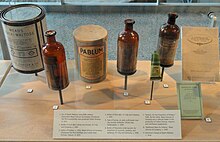Pablum

Pablum is a processed cereal for infants originally marketed by the Mead Johnson Company in 1931. The trademarked name is a contracted form of the Latin word pabulum, which means "foodstuff". The name had long been used in botany and medicine to refer to nutrition or substances of which the nutritive elements are passively absorbed.
The word can also refer to something that is bland, mushy, unappetizing, or infantile.
History
Pablum was developed by Canadian pediatricians Frederick Tisdall, Theodore Drake, and Alan Brown,[1] in collaboration with nutrition laboratory technician Ruth Herbert (all of the Hospital for Sick Children in Toronto), along with Mead Johnson chemist Harry H. Engel.[2] The cereal marked a breakthrough in nutritional science: it helped prevent rickets, a crippling childhood disease, by ensuring that children had sufficient vitamin D in their diet.
Although neither Pablum nor its biscuit predecessor[3] was the first food designed and sold specifically for babies, it was the first baby food to come precooked and thoroughly dried. The ease of preparation made Pablum successful in an era when infant malnutrition was still a major problem in industrialized countries.[citation needed]
Pablum Mixed Cereal was made from a mixture of ground and precooked wheat (farina), oatmeal, yellow corn meal, bone meal, dried brewer's yeast, and powdered alfalfa leaf, fortified with reduced iron – providing an assortment of minerals and vitamins A, B1, B2, D, and E.[1][4] Pablum is palatable and easily digested without causing side effects like diarrhea or constipation. It is also unlikely to cause allergic reactions,[citation needed] as it does not contain eggs, lactose or nuts of any kind (although it does contain wheat and corn, either of which can be allergenic for some individuals).
For a period of 25 years, the Hospital for Sick Children and the Toronto Pediatric Foundation received a royalty on every package of Pablum sold. In 2005, the Pablum brand was acquired by the H. J. Heinz Company.
See also
References
- ^ a b ""Better Foods, Improved Nutrition: Pablum and Children's Health"". Mta.ca. Retrieved 2010-01-12.
- ^ "Harry H. Engel" New York Times, April 2, 1984
- ^ Frederick F. Tisdall, M.D., T. G. H. Drake, M.B., Pearl Summerfeldt, M.B., and Alan Brown, M.B. A NEW WHOLE WHEAT IRRADIATED BISCUIT, CONTAINING VITAMINS AND MINERAL ELEMENTS Can Med Assoc J. February, 1930.
- ^ "EFFECT OF ADDED LYSINE ON GROWTH OF RATS FED A CEREAL AND MILK DIET", The Journal of Nutrition, (Received for publication April 12, 1956)
